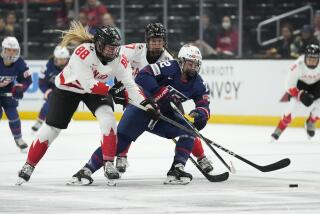NOT ROLLING IN DOUGH : You Won’t Find a Lot of Millionaires on the Ladies Pro Bowlers Tour
- Share via
SAN DIEGO — Keep in mind, this isn’t life styles of the rich and famous.
Women on the Ladies Pro Bowlers Tour, now at Kearny Mesa Bowl for a four-day tournament, don’t make enough in an entire year to pay for an Orel Hershiser strikeout.
Golfers come to town, they might stay at the Marriott.
Tennis players probably bunk at the Hilton.
Female bowlers? Try Joe’s Motel.
“If you talk to golf and tennis people,” says Lisa Wagner, the LPBT’s top competitor, “they can’t believe we don’t stay at the Hilton or the Marriott.”
Believe it. Money is thin. Judy Soutar has been on the tour since it began 29 years ago. Her career earnings total $169,302. That’s almost pocket change for Chris Evert.
When Soutar and husband Dave, who bowls on the men’s tour, go to borrow money, she cannot be too precise when asked about her income. Lenders want exact figures, but there are no exact figures in pro bowling. Some weeks you might strike it rich. Most weeks you don’t.
Aleta Sill tops the career salary chart with $301,069. Eight others, including Wagner and Betty Morris, a 19-year tour veteran, have earned more than $200,000. By the time you get down to 35th on the all-time earning list, the figure is $50,652.
So bowlers who aren’t independently wealthy need to be creative and resourceful. Soutar makes do because of her Brunswick sponsorship, which enables her to supplement her bowling income by serving on an advisory staff and doing promotions. But plenty of others have tried the tour on their own and gotten fed up.
“It’s too nerve-racking to try to make a living out here,” said Soutar, who estimates only about 10 professionals make enough money to use the tour as their sole source of income. “I never paint a rosy picture. It’s hard for a young girl to come out on the tour. When you come out here, you better be prepared.”
Soutar remembers her early years. She is supportive of newcomers. Some veteran bowlers aren’t, seeing a new bowler as another mouth to feed.
As a rule, though, professional bowlers seem to stick together and deal with the shortcomings of a sport that has never had a “Battle of the Sexes”--a la Bobby Riggs and Billie Jean King--to help put it on the map.
To save money, professional bowlers rent cars together. They share rooms. For better or worse. Wagner said things haven’t been that easy during this week’s stay in San Diego. Sunday night, some of the bowlers received crank calls in the middle of the night.
“Everybody is in the same boat,” Morris said. “I think to a certain extent everybody wants each other to bowl well. We’re all out here trying to make a living.”
That isn’t easy on the LPBT. Bowlers do countless promotions in attempts to give the sport a shot of life. What will it take to attract the big money?
A “Battle of the Sexes” hasn’t been ruled out. Morris, chosen “Bowler of the Decade” for the 1970s by Bowlers Journal, has tried repeatedly to set up a match with one of the top bowlers on the men’s tour. No takers so far.
Increased TV support would help. The biggest difference between the men’s tour and the women’s is network television. The men have a contract with ABC. The women have recently signed with ESPN, but the exposure is limited.
Corporate sponsorship also has given the men’s tour a boost. Firestone took the first step several years ago; within a year, other sponsors followed. The biggest women’s sponsors are bowling companies, which don’t have the money or interest to fund the entire tour.
There isn’t much difference in the quality of bowling between the men and women, but there’s a significant difference in the earnings. Soutar said the men average between 6 and 8 pins more a game and make at least twice as much.
Few realize that there is a lot famine between each feast on the women’s tour.
“If I win $5,000 in a week (people) think I make $200,000 a year,” Soutar said. “They don’t see the weeks I don’t make any.”
Things have gotten better. In the early days, the tour wasn’t really a tour at all. There were only about 10 tournaments a year. All bowlers held full-time jobs and traveled to tournaments as more of a hobby than anything else.
Morris worked in a bowling alley and practiced in her spare time, which she said was distracting. Later in her career, she sold draperies. It was only a year and a half ago that she signed a contract with AMF and made bowling her full-time occupation.
“If you have an endorsement contract, you can make a good living,” Morris said. “If you don’t have a contract, it’s very, very difficult. There are so many girls on the tour that work full-time. They should be commended.”
Everything about the women’s tour seems to have changed over the years except the money. Bowlers in the first professional tournaments were equipped with rubber bowling balls. The pins were heavier, the lanes made of lacquered wood. Scores were lower.
Now, bowling is state of the art. Balls and lanes are made with urethane. Scores have gotten much higher, and knocking pins down has become less work. Bowlers in the past had to put a lot more spin on the ball to get desired pin action. Morris says she still has to hold herself back from putting as much turn on the ball with the newer equipment.
“It’s just a totally different release,” she said.
It’s also a totally different life style. Bowlers used to travel to tournaments with their entire families. Morris raised a child while on the tour. Soutar has four children. Today, with the LPBT covering 26 stops, many of the bowlers are single.
If there is a primary focus for those attempting to give women’s bowling a boost, it might be to change the image of the sport as a whole. Soutar said bowling still has a blue-collar image, which comes associated with beer drinking. That’s hard to change. Many of the sponsors of the tour are beer companies.
But what is often overlooked is that bowling has a more widespread appeal as a recreation sport than tennis and golf. It’s a sport for the masses.
“Where I live in Kansas City,” Soutar said, “there’s a lady who bowls who is 102. She couldn’t play tennis.”
Though bowling is established nationwide as recreational sport, it might take awhile before people who do it professionally get bigger paydays. Making a living takes a little luck and a lot of skill.
Wagner, the 1988 LPBT Player of the Year, was fortunate when she started on the tour 10 years ago. She won $2,000 at an amateur tournament before turning pro and used it to fund her first few tournaments. From there, her career took off. Of course, she is considered the best there is. Soutar said in her 29 years she hasn’t seen anybody with nearly as much talent.
“There’s no comparison,” Soutar said.
For the rest, it’s different. And even Wagner is aware the future is uncertain.
“Your potential to be a big money winner is probably not going to go past 40,” she said. “Then you’ve got 25 years until you retire.”
More to Read
Go beyond the scoreboard
Get the latest on L.A.'s teams in the daily Sports Report newsletter.
You may occasionally receive promotional content from the Los Angeles Times.










